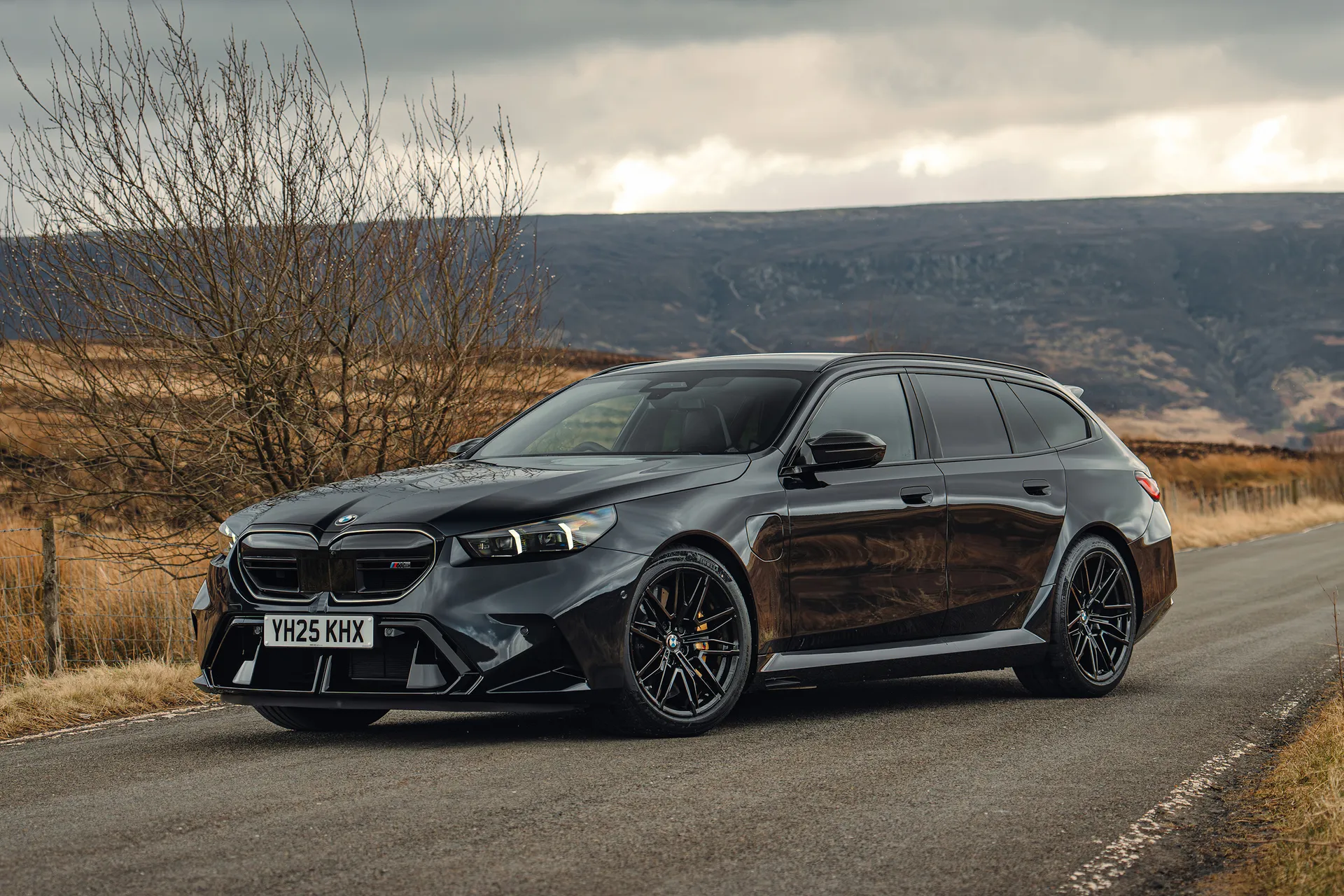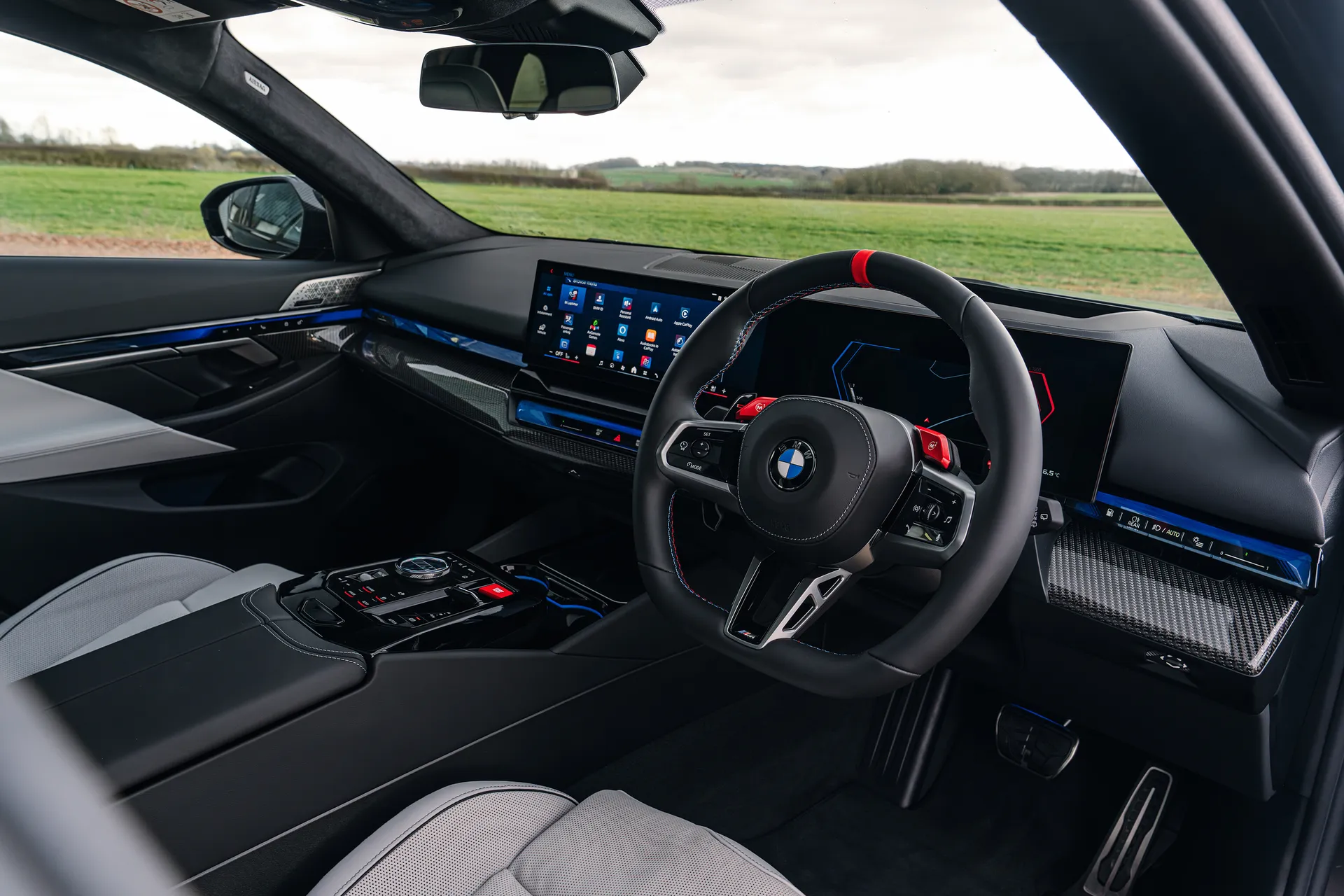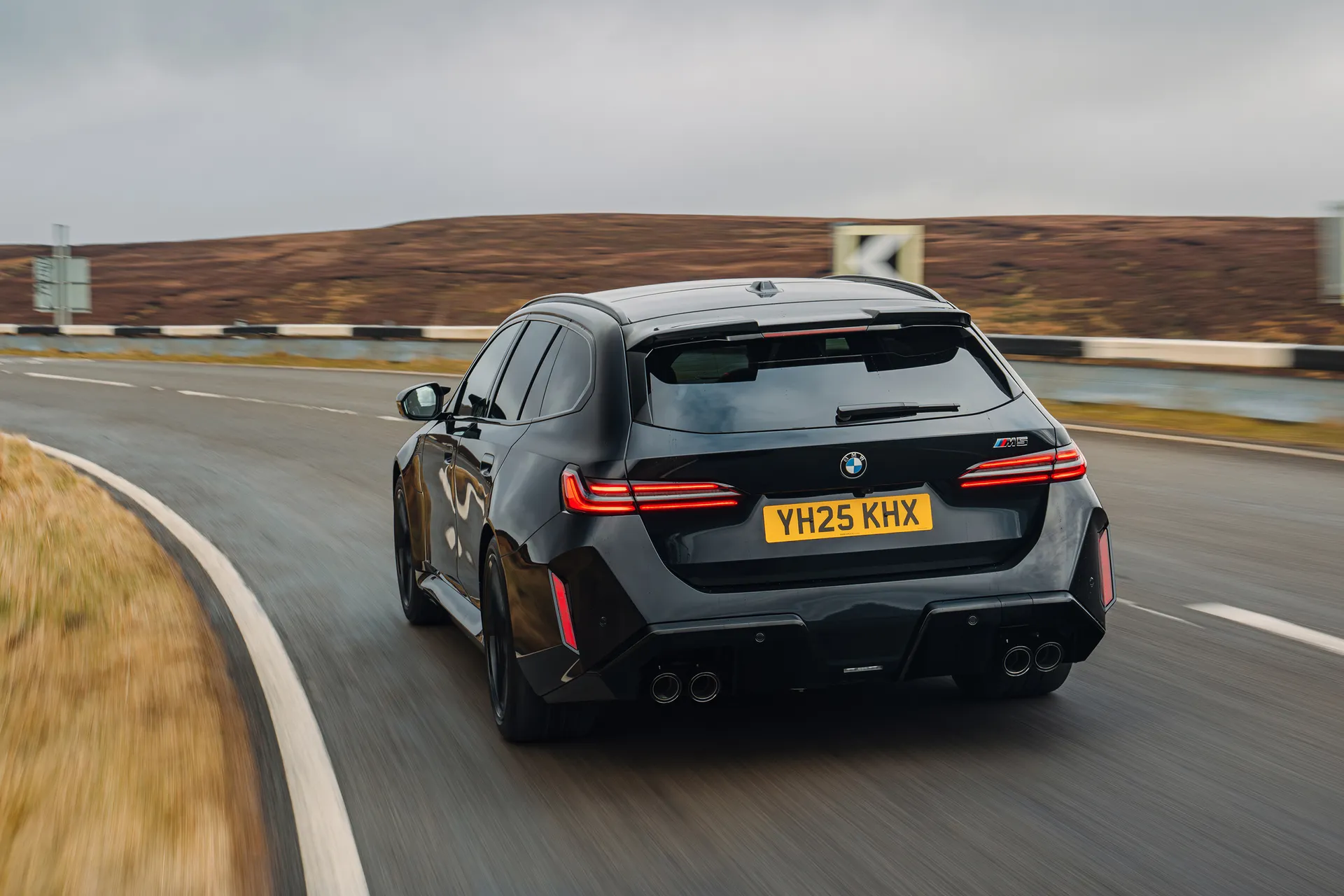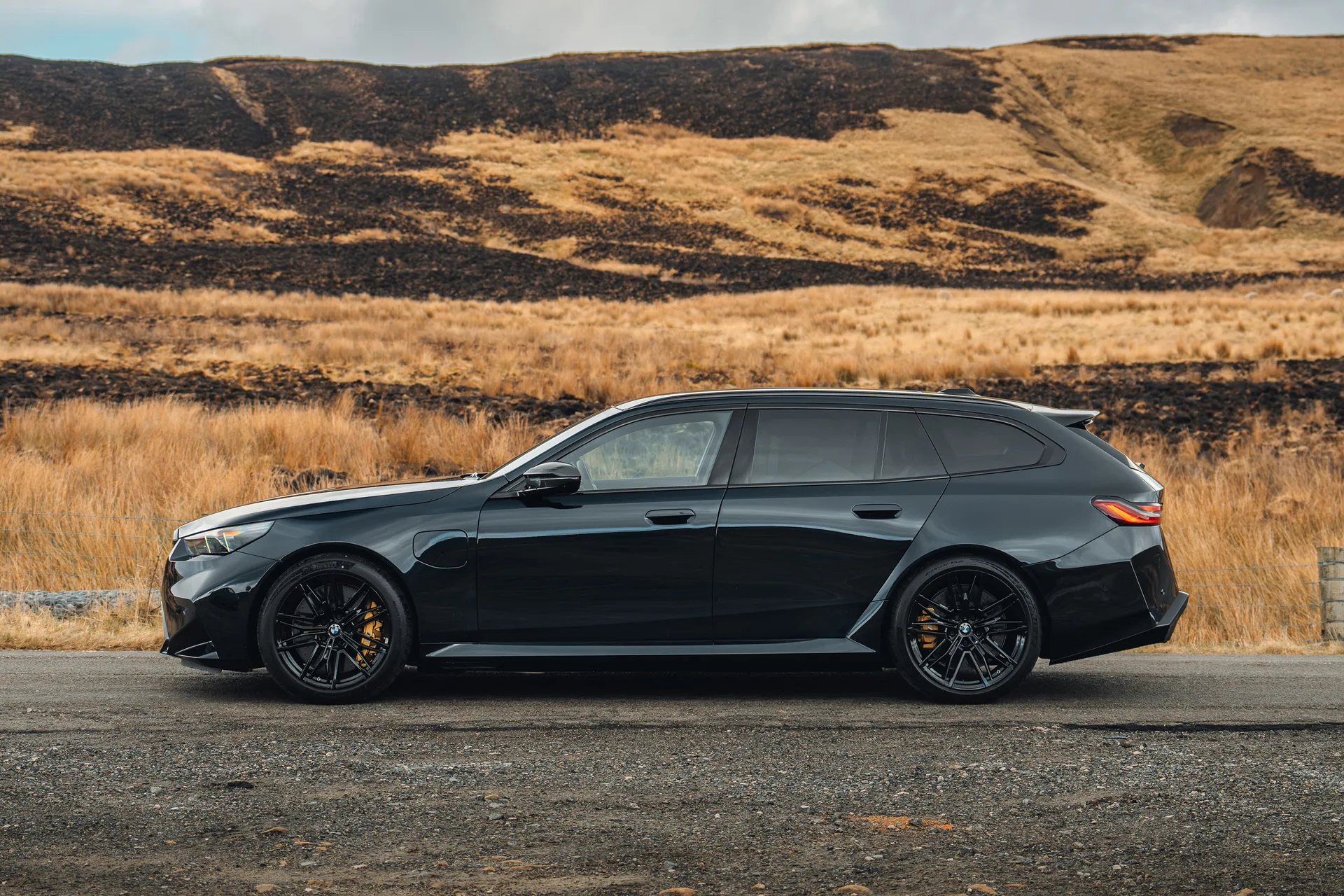BMW M5 Review
Written by Matt Robinson
Quick overview
Pros
- Outrageous performance and cornering capability
- Finally available as an estate
- Hybrid powertrain means cheap company car tax
Cons
- Estate doesn't actually offer that much boot space
- Bewildering choice of setup options takes time to understand
- Probably too fast for its own good
Verdict: Is the BMW M5 a good car?
"Much attention was paid to the weight figure of the new BMW M5 when it was first revealed, but should we be getting caught up in all that? After driving it for the first time, we'd have to say no. Find out why in our full BMW M5 review."

We might as well get this out of the way now – the new BMW M5 weighs the best part of 2.5 tonnes. That's a lot for a big SUV, let alone a mid-sized saloon car. The reason is that this is the first-ever M5 hybrid, and its 18.6kWh high-voltage battery and associated parts up the bulk considerably.
The electrified bit of the equation also adds power, though, so this is comfortably the most powerful M5 we've ever seen, pushing out an enormous 727PS. The result is...a car that's slightly slower than the previous one when accelerating from 0-62mph.
The figures don't tell the full story in terms of the driving experience, as we'll get to later in this review. Plus, it can cover over 40 miles on a full charge, and thanks to that healthy range figure, the company car tax is very low. This means that despite costing a whopping £111,515 if you're paying up front, it's possible to get behind the wheel of a new M5 for a relatively modest monthly outlay.
We haven't even gotten to the best bit yet, which is that for the first time in around 15 years and only the second time in right-hand drive, it's possible to order an M5 Touring. In terms of practicality, it might not wow you due to packaging reasons, but doesn't it look brilliant in wagon form?
On the downside, the M5 is hellishly complicated, giving you arguably far too much choice in terms of how you can set up various parameters, including how the aggressiveness of its gear changes and how firm the suspension is. With some tinkering, though, we reckon we can give some guidance on that front.
Looking for a used car for sale? We've got 100s of BMW Approved Used Cars for Sale for you to choose from, including a wide range of BMW M5s for sale.
Is the BMW M5 right for you?
If you're after a scorchingly fast performance car that's still quite practical and luxurious, absolutely. Normally, we'd say you also need to have quite a bit of spare cash lying around, but if you're a company car user, that won't be necessary. The monthly outlay will vary depending on how much tax you pay, but it could be only a few hundred quid a month.
What’s the best BMW M5 model/engine to choose?
With the M5, you only have one choice to make – do you go for the saloon or the Touring? On that front, we'd go for the latter. Yes, the boot space you get isn't brilliant for an estate of this size, but the price difference is marginal, and it'll be much easier to load bulky items into the back of the Touring. Most importantly of all, it's just cooler, we think. This is the first M5 Touring to be available for around 15 years, so it's likely to get a lot of attention.
What other cars are similar to the BMW M5?
The M5's arch rival has long been the Mercedes-AMG E63, but the most recent one is no longer available, and it's thought the next-generation version which ditch its V8 for a less theatrical inline-six. There's also the Audi RS6 Performance, which makes for an excellent foil for the M5 Touring. It's set to bow out pretty soon, set to be replaced by a car which, like the M5, is expected to be powered by a hybrid V8.
The Porsche Panamera could be considered a rival, although the GTS and Turbo E Hybrid versions that rival the M5's performance cost quite a bit more. Finally, there's an alternative that's quite close to home – the BMW M3. Yes, it's far less powerful, but it's also a lot lighter, which means it accelerates from 0-62mph a little quicker than its bigger brother, and the boot space in the Touring version is actually bang on the figure of the M5.
Comfort and design: BMW M5 interior
"The M5's cabin largely follows that of the 5 Series it's based on, but with some additional racey touches. The iDrive system is slick, but we'd rather not have to use the touchscreen for so many functions."

Like the BMW 5 Series, the M5's cabin is dominated by one large, curved panel housing both a 14.9-inch infotainment system and a 12.3-inch digital instrument cluster. You also get the 'Interaction Bar', which is a light-up panel stretching across the cabin and linked to various functions. For instance, if you stick the hazard lights on, the whole lot lights up red. Most of the time, it displays a mix of blue and red, evoking the BMW M Division logo.
The seats are comfortable and extremely supportive, and thankfully, there's no option to add the daft carbon fibre-backed seats seen in some other M models which feature (for some reason) carbon fibre trays between your legs, and holes in the back which kids will almost certainly utilise to annoy whoever's in the front.
There's a dizzying array of interior trim options should you want to spruce things up further, including some punchier leather trim colours (we quite like the Kyalami Orange option) and carbon fibre dashboard inlays.
Quality and finish
The M5 needs to be spot on in this department, considering its price tag, and fortunately, it largely delivers. All the materials you come across are of top-notch, premium-feeling quality, and everything's put together beautifully. Our one complaint is one we make commonly in modern cars, so the M5 can't be singled out in this regard. We're talking about the use of shiny black plastic, which tends to show up scratches quite conspicuously, and in no time at all.
Infotainment: Touchscreen, USB, nav and stereo in the BMW M5
The M5 runs iDrive 8.5, and although the menu system isn't quite as straightforward as some earlier versions of the software, it doesn't take long to get used to it. The 14.9-inch touchscreen is very responsive, but you don't necessarily have to use it.
While BMW has been deleting the classic rotary iDrive controller in its smaller cars, it's still very much a thing in bigger models like the 5 Series. We're pleased it's still there, because tactile controllers like this are considerably easier to use on the move than a touchscreen. What's more, there's something extremely satisfying about the way it gently clicks as you rotate it.
The in-built navigation is one of the better OEM systems, and it includes up-to-date traffic data. It's one of the few manufacturer nav systems you won't want to immediately bin off in favour of Google Maps via your smartphone. If that's your preference, though, Apple CarPlay and Android Auto are included as standard.
Along with the touchscreen, there's a crisp and comprehensive head-up display fitted at no extra cost, which is able to show mapping data. Also included is an excellent Bowers & Wilkins sound system.
The M5 is well proportioned in terms of USB connectivity, with two USB-C sockets at the end of the phone tray, a further two under the front armrest, and a final pair for rear-seat passengers.
Space and practicality: BMW M5 boot space
We normally sing the praises of the 5 Series plug-in hybrid models for not losing any boot space relative to their pure combustion counterparts, but sadly, we can't do that here. It's all to do with packaging the hybrid battery and the M5's clever electronically controlled rear differential, which leads to a sizeable drop in volume.
The saloon can take 466 litres, down from 520 litres, while the estate manages 500, a drop of 70 litres compared to other 5 Series Touring models. That's no more than you get in the smaller M3 Touring, although the M5 wagon does much better than its little brother once the rear seats are folded, offering 1,630 litres compared to 1,510 litres.
In the Touring, there's a load cover which can be retracted or removed entirely. Using handy levers in the boot, the rear bench can be easily folded in a 40/20/40 split.
Further forward, there's a lidded compartment under the central armrest offering a good amount of storage, and near there are a pair of cupholders. The door bins aren't massive, we should point out.
You won't have complaints from anyone in the front about space, and legroom in the rear is decent, but thanks to a sloping roofline in both versions of the car, taller rear-seat passengers might not be so happy about the headroom
Handling and ride quality: What is the BMW M5 like to drive?
"The M5 is sensational to drive, with the hybrid system enhancing rather than detracting from the experience. And no, it doesn't feel anything like as heavy as it actually is."

It defies belief how the M5 is able to shrug off its considerable weight figure. Given the way it changes direction, you'd swear it weighs several hundred kilograms less than it actually does. The steering is nicely weighted, depending on the mode (more on that soon), and it even delivers meaningful feedback from the road surface, which is a rarity these days.
There's barely any body roll, and traction from the all-wheel drive system is phenomenal, allowing you to aggressively accelerate out of a bend much earlier than a lot of cars are happy with. It still feels like a traditional BMW with a noticeable bias toward the rear, which is exaggerated further in the 4WD Sport mode.
Body roll is pretty much nonexistent, as you'd expect for a car so stiff. Even with the adaptive suspension in its softest mode, the ride can get a bit choppy over some surfaces, robbing you of a bit of confidence in the car. The two firmer modes are unusable on all but the smoothest of roads.
And yes, the modes. There must be thousands upon thousands of different combinations (you're welcome to do the maths), with multiple settings for the traction control, suspension, steering, engine, gearbox, energy recovery, the hybrid system, the 'M sound' and the all-wheel drive system. There are also overarching Road, Sport and Track modes that are more about what the displays look like and how many driver assistance systems are turned on.
Exactly how you set the car up is going to depend on personal preference, but for sporty driving, we reckon we've cracked it. And that's to turn pretty much everything up to full apart from the steering and suspension, while activating the M Dynamic Mode (MDM). The latter is more lenient but still has a big safety net, and also activates the more playful 4WD Sport mode. Oh, and we tended to turn off 'M Sound', as the fake V8 noise this pumps through the speakers is a bit rubbish.
What engines and gearboxes are available in the BMW M5?
There's only the one combination available in the BMW M5, which mixes a 4.4-litre, twin-turbo V8 with an eight-speed automatic gearbox containing an electric motor. The latter is powered by an 18.6kWh battery pack.
While the 727PS and 1,000Nm of torque outputs are a significant step up from the old M5 Competition, the new M5 is actually a tenth slower when accelerating from 0-62mph, taking 3.5 seconds, with the M5 Touring a further tenth behind. That said, it's quite conceivable that BMW will make a faster Competition version of the new M5.
In any case, we wouldn't worry too much about the raw numbers. That's because the way all that power is delivered has been fundamentally altered, with the electrical side of the equation boosting low-down torque and making up for the lag of the turbochargers.
The result is a car that's wickedly responsive. Almost too responsive. It's so eager to pick you up and lob you down the road at terrifying speeds that the M5 begins to feel too much for anywhere that isn't a derestricted autobahn. It's unhinged.
Not that it sounds all that bonkers. As mentioned, the 'M sound' is a bit naff, so we preferred to turn it off, but the V8 on its own is quite muted.
Refinement and noise levels
Although you won't hear much of the engine inside the cabin, you do get a lot of tyre noise. The M5's footprint is massive, with 285mm wide tyres at the front and 295mm tyres at the rear. On some road surfaces, the 'roar' from the tyres is such that you might want to turn the sound system volume up a bit. Wind noise isn't as much of an issue, at least.
Safety equipment: how safe is the BMW M5?
Euro NCAP is unlikely to crash test a valuable car like the M5, but the safety body did assess the standard 5 Series, which is built around the same structure, in 2023. There's good news on that front, as the 5 Series achieved the full five-star rating with 89% and 85% given in the adult occupant and child occupant categories, respectively.
Standard safety equipment includes lane assistance, autonomous emergency braking, blind-spot detection and speed limit recognition. You can enhance the electronic safety suite further, with things like evasion assistance and a wrong-way warning system added with the £2,100 Driving Assistant Professional package.
MPG and fuel costs: what does a BMW M5 cost to run?
"The official MPG figure of up to 176.6mpg is worth ignoring, because of the way the current testing procedure paints plug-in hybrids in a very flattering light."

What's perhaps more useful is the figure BMW quotes for the car with a discharged high-voltage battery, which is 27.7mpg. Drive hard enough, and you might see a number that's barely into double digits. Don't ask us how we know.
Then again, with an electric-only range of up to 41.6 miles, you could avoid using any petrol at all during day-to-day driving, depending on what your commute is like and the availability of charging at either end. Just bear in mind you're more likely to get around 30 miles, which is still decent.
BMW M5 reliability and warranty
As such a new model, it's hard to tell how the M5 will fare in terms of reliability in the long term. The best we can do for now is look at how well BMW did as a brand for reliability in the most recent HonestJohn.co.uk Satisfaction Index ownership survey, which was 16th out of 33 manufacturers with a score of 89.92%.
The M5 has the same length of warranty as any other BMW, lasting for three years with unlimited mileage. Like all the brand's plug-in hybrids, the battery is covered by a separate warranty also lasting 60,000 miles, but for six years rather than three.
BMW M5 insurance groups and costs
Good news! The new M5 isn't in the top insurance group. Bad news? It's only one place lower, at 49. It'll be especially important to shop around here, and you might want to try a few specialists to see if you can get the premium down.
VED car tax: what is the annual road tax on a BMW M5?
The (really rather pointless) £10 Vehicle Excise Duty (VED) discount given to hybrids has been binned, so you'll pay the same £195 annual rate from year two as anyone else. A low emissions figure makes for a modest first-year rate of just £110, but you're unlikely to care, given that this is absorbed by a six-figure on-the-road price for the car.
You might be a bit more concerned about the government's luxury car tax annual surcharge of £425 from years two to six of ownership. Given that the threshold is £40,000, the M5 has no chance. And as it's based on the original RRP with options and transferred to subsequent keepers, buying used won't get you around it. Sorry.
BMW M5 price
"Costing over £110,000 before you've added some of the pricey options, the M5 isn't cheap to buy. It is, however, cheap (considering its performance) to run as a company car."

The M5 saloon is yours from £111,605, while the starting price of the M5 Touring is £113,605. It's possible to spend more than that, as well. A lot more. If you want a BMW Individual Special Paint, for example, it's going to be over £5,000. There's a Comfort Pack adding things like ventilated front seats and roller sunblinds for £1,800, while the M Driver's Pack (this increases the top speed to 190mph and includes a driving experience voucher) is £2,200. Or, you can bundle a lot of the pricey options into the Ultimate Pack for, wait for it, £19,500. Ouch.
That might sound like a lot, but it's par for the course with cars like this. The Audi RS6 Performance is £120,195 before you've added any options, while a Porsche Panamera Turbo E Hybrid is over £150,000.
It's too soon to be talking about used M5s, but there are plenty of pre-registered examples at dealers offering significant savings on the RRP.
Trim levels and standard equipment
The M5 is a single trim level. As standard, it includes a 'staggered' set of 20-inch front/21-inch rear wheels, adaptive LED headlights, ambient lighting, four-zone climate control, an electrically adjustable driver's seat, leather steering wheel, wireless smartphone charging, front and rear parking sensors with a reversing camera, adaptive suspension and a powered tailgate.
Ask the heycar experts: common questions
How much does the new BMW M5 weigh?
How much does the new BMW M5 Touring cost?
How fast is the new BMW M5?
Get our latest advice, news and offers
Keep me updated by email with the latest advice, news and offers from heycar.
By submitting you agree to our privacy policy



